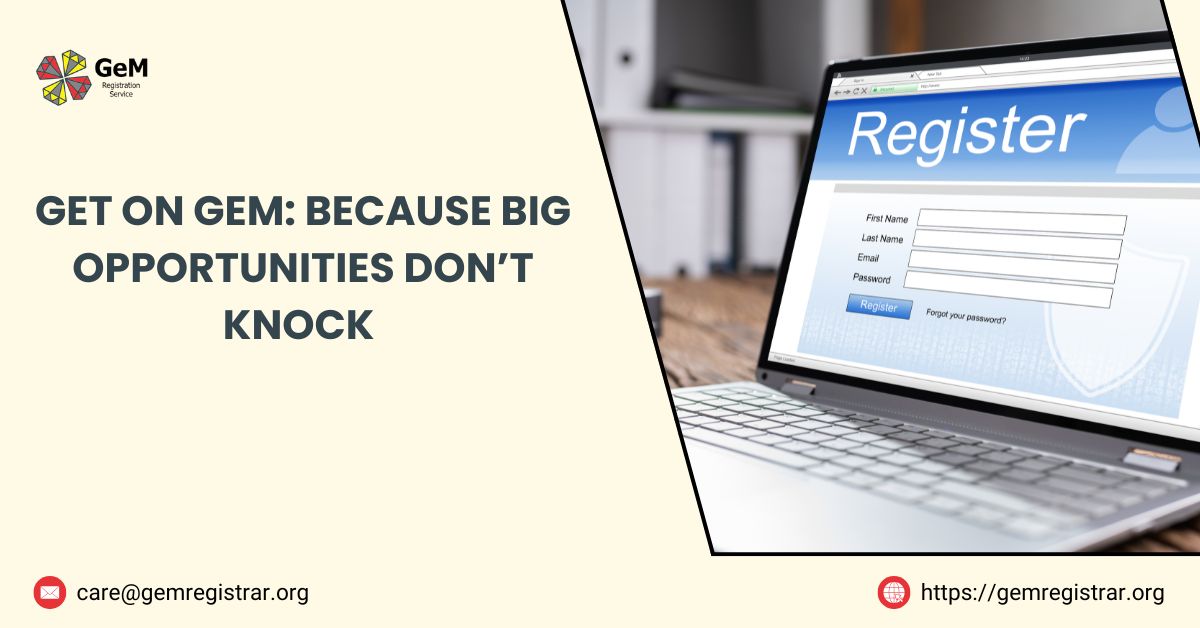
Introduction
In today’s fast-paced digital world, opportunities come swiftly and leave just as quickly. For Indian businesses looking to grow, gain visibility, and establish trust, few platforms offer as much promise as the Government e-Marketplace (GeM). Launched by the Government of India in 2016, GeM is not just another procurement portal—it’s a digital gateway to the country’s largest buyer: the Indian government. With billions of rupees flowing through government tenders every year, GeM Portal is a golden opportunity for suppliers, manufacturers, service providers, and entrepreneurs to reach a vast and credible market. If you’re not already on GeM, it’s time to ask yourself: what are you waiting for?
What is GeM?
The Government e-Marketplace (GeM) is an online platform that facilitates the procurement of goods and services required by various government departments, organizations, and public sector undertakings (PSUs). Designed to promote transparency, efficiency, and ease of doing business, GeM has revolutionized public procurement in India. GeM offers a paperless, cashless, and contactless process. It allows vendors from across the country—including MSMEs, startups, and large enterprises—to sell to verified government buyers, all through a streamlined and accessible online portal.
Why GeM Matters Now More Than Ever
As India moves towards a more transparent and digital economy, platforms like GeM have become indispensable. Post-pandemic, the demand for contactless and efficient procurement systems has skyrocketed. GeM fits the bill perfectly by providing an end-to-end digital solution. Moreover, the government’s focus on “Make in India” and “Atmanirbhar Bharat” has fueled a push towards sourcing from domestic suppliers. GeM prioritizes local products and services, empowering Indian businesses to compete and thrive.
The Big Opportunities on GeM
1. Access to India’s Largest Buyer
When you register on GeM, you gain access to thousands of government departments and PSUs. These buyers have diverse needs, ranging from office supplies and IT services to infrastructure and consulting. The sheer volume of business opportunities is unmatched.
2. Equal Opportunity for MSMEs and Startups
GeM is designed to level the playing field. It gives MSMEs and startups a fair chance to compete with larger companies by offering preferences and exemptions under specific categories. GeM Startup Runway and MSME corner are dedicated segments to boost participation.
3. Transparency and Fairness
Traditional government procurement systems often suffered from a lack of transparency and bureaucratic delays. GeM ensures complete transparency in bidding and procurement. Every step is traceable, and every transaction is documented.
4. Faster Payments
One of the biggest hurdles for vendors in government business has been delayed payments. GeM mandates payment within 10 days of goods acceptance, providing better cash flow for sellers.
5. Brand Visibility and Trust
Selling on GeM builds credibility. Your products and services are showcased to a trusted buyer base. Consistent performance can lead to repeat orders and long-term relationships with government departments.
Getting Started on GeM
Registering on GeM is simple. You need basic documents like PAN, Aadhaar, business registration certificate, and bank details. Once verified, you can list your products or services, set your prices, and start receiving orders.
1. Access the GeM Portal
Start by visiting the official Government e-Marketplace (GeM) portal. This is where you’ll begin the registration process to sell your products or services to various government departments.
2. Enter Your Basic Information
Fill out the initial registration form with your key details such as your name, contact number, email address, and date of birth. Be sure to provide valid and up-to-date information to avoid any issues later in the process.
3. OTP Verification
After submitting your basic details, you will receive a One-Time Password (OTP) on your registered mobile number or email. Enter this OTP to verify your identity and proceed.
4. GeM Call Confirmation
Once your OTP is verified, a representative from the GeM platform may call to confirm your registration and verify the details you’ve submitted.
5. Finalize Registration
After successful verification, your registration will be officially completed. You will then receive your GeM Seller ID and login credentials via your registered email address.
6. Set Up Your Seller Profile
Log in to the GeM portal using the credentials provided. Next, complete your seller profile by adding information about your business, uploading required documents, and setting preferences for product categories and services.
7. Submit Caution Money
Before listing products, you’ll be prompted to deposit a caution money fee. The amount depends on the nature of your business and the category of goods/services you intend to offer. This is a mandatory step to ensure your account is active for transactions.
8. Add Product Listings
Navigate to your dashboard and click on the “Product Listing” option. You can add new products or manage the ones you’ve already uploaded. Ensure that product descriptions, pricing, and specifications are accurate and clear.
9. Choose the Right Product Categories
Selecting the correct category is crucial for visibility. Categorize your products accurately so that government buyers can find them easily through the platform’s search functionality.
10. Begin Selling to the Government
Once your products are live, you become visible to various government organizations, departments, and ministries. You can now receive orders and fulfill procurement requirements across India.
Suggested read- list of item on Gem portal
Conclusion
Opportunities like GeM don’t come often. As the platform continues to expand, integrate with state governments, and launch new features, the scope for sellers will only grow. But early movers have the advantage of less competition and greater visibility. Getting on GeM is not just a business decision—it’s a strategic move towards sustainable growth. Whether you’re a budding entrepreneur, a family-run SME, or an established player, the time to act is now.